Army Under Secretary Scopes Out Sensors: Fielding Fast
Posted on
FORT BELVOIR: The fog of war is getting thinner. Sure, the US Army expects future combat to be as brutally chaotic as ever, but as researchers showed the service’s No. 2 civilian here yesterday, soldiers will have new sights and sensors to let them see through darkness, dust storms, the ground, and even literal fog. It’s enough of an advantage to save lives.
Under Secretary Ryan McCarthy, a former Army Ranger now putting together the 2020 budget, saw a host of technologies and demonstrations here at Fort Belvoir on Tuesday. The common theme? New sensors, combined with the computing power to display their data intelligibly so soldiers can use it tactically.
In one demonstration, for example, McCarthy watched an indoor shooting range fill with smoke, which a soldier proceeded to shoot through, unaffected. (See the video above). A sensor called FWS-I (Family of Weapon Sights – Individual) allowed the soldier to see the target as if the smoke wasn’t there.
That’s the kind of edge the US Army is eager for. Decades ago, the Army took the lead on night vision and, combining tactics and technology, “owned the night,” able to operate in conditions that hamstrung its opponents. But now night vision has spread not just to rivals like Russia but irregulars like the Taliban. Being able to see through the dust and smoke that obscure the modern battlefield — while your enemies can’t see you, let alone shoot you — could be a crushing advantage.
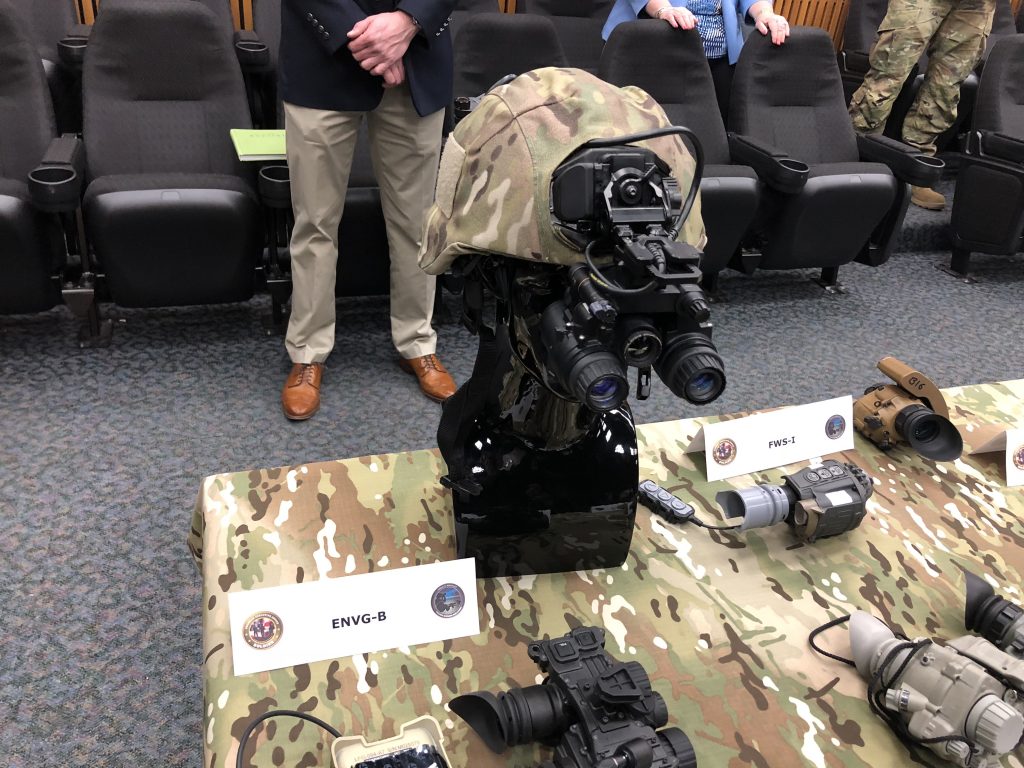
Enhanced Night Vision Goggle – Binocular (ENVG-B) on display next to older models of sight.
Sensors for Soldiers
The hottest item on display was one of the smallest: the ENVG-B head-mounted sight entering service this fall — probably in December, according to Army officials at Fort Belvoir. The sight so excited Army leaders, and its development was so far along, that ENVG-B was accelerated to become the first piece of kit entering service as part of the new Big Six modernization program. The Army wants to issue it ASAP to all infantry soldiers and scouts, with the Marines and Special Operations interested as well.
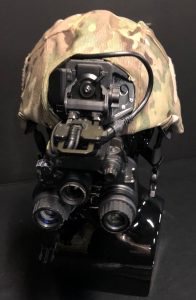
ENVG-B
Why so sexy? Formally the Enhanced Night Vision Goggle – Binocular, the ENVG-B combines light enhancement for both eyes, giving depth perception in the dark (hence “binocular”), with infrared (in one eye), superimposing both views on a single display. It can also superimpose a navigational pointer from its built-in compass.
Plugged into the right kind of gunsight, the ENVG-B will further superimpose cross-hairs telling the soldier exactly where his or her weapon is aimed. (The technical term here is Rapid Target Acquisition). Plugged into the Nett Warrior networking device, the ENVG-B can also display pointers showing the direction to friendly troops, reported enemies, and tactical objectives. Historically, to get all this information, a soldier would have to look at one device, then another, then another — weighing him down with gadgetry and potentially taking his eyes off potential threats as he looked down at a screen or compass.
The Army actually let reporters try on a helmet kitted out with the ENVG-B and counterbalancing battery pack. That was pretty gutsy considering (a) I’d already almost knocked a $10,000 sight off the table and (b) the ENVG-B costs even more, with the Army hoping to get its price below $23,000 a soldier.
Once I had it on, I had three thoughts, one after another:
- This is neat.
- This is heavy.
- I can’t actually see that much.
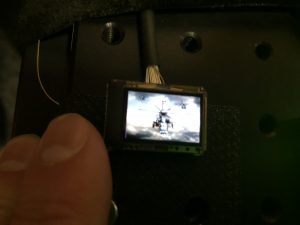
An experimental organic-chemistry LED screen, next to the photographer’s fingernail. (This shot doesn’t do justice to how crisp the display looks in real life).
It turns out that the ENVG-B, for all its advances, still has the same narrow field of view as current night vision devices: a 40 degree cone directly in front of your face. The problem is that, in combat, peripheral vision is pretty important.
So how to get a wider view? Part of the answer was on the other side of the same room: a display of tiny LEDs — using organic chemistry instead of traditional methods — that provide a clear, crisp image on a screen the size of my thumbnail. On a normal screen, an individual pixel is 200 microns wide, or about 0.008 of an inch; on these screens, a pixel is 10 microns, or 0.0004 inches. Built into a heads-up display and mounted on a helmet, the organic LEDs could provide a low-power, high-resolution way to give soldiers some peripheral vision while using the latest sights.
Sensors for Vehicles
The bane of Army helicopters in the Middle East hasn’t been enemy fire: It’s been dust, thick clouds of it kicked up by their rotors as they try to land which blind the pilots to potential obstacles. The blandness of the official term, “Degraded Visual Environment,” believes the real danger. “I’ve lost more friends due to degraded visual environment than to enemy action,” one aviation veteran told Under Secretary Ryan.
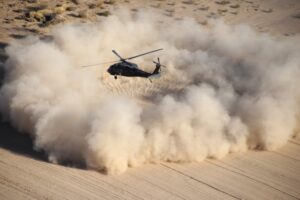
An Army UH-60 Black Hawk tries to navigate through the dust cloud created by its own rotors.
To demonstrate the latest DVE sensor, Army soldiers and civilians filled an air-tight tent with blowing sand — completely obscuring vision in seconds — while a nearby screen showed the view through the sensor: black-and-white but perfectly clear. Even the trees beyond the demonstration area were distinct.
Using a prototype sensor, a UH-60 Black Hawk helicopter has made over 600 landings at desert test sites, the demonstration team said. They also tried the sensor on a CH-47 Chinook, a huge helicopter that produces huge clouds of dust, and the crew liked it so much they didn’t want to give it up.
The next step, the researchers said, will be to get the sensor to see through atmospheric moisture such as fog — not much of an issue in Iraq but potentially a big problem in Eastern Europe.
Sensors can also look underground, say for buried land mines. Consider the Husky vehicle, a kind of Mad Max contraption that looks for roadside bombs. A mainstay in Afghanistan and Iraq, it would still be relevant in a war with Russia, which has stockpiled millions of land mines, including offensive types that can be scattered at long range by rocket launcher.
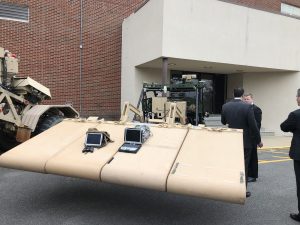
Mine-clearing robot (with full-sized Husky mine-clearing vehicle in background)
The Husky’s been upgraded with ground-penetrating radar, but the human operator has to eyeball the screen and interpret the often ambiguous signals. That means the vehicle has to crawl along at about three miles an hour to give the driver time to recognize a mine and stop before running over it.
But now Army researchers have developed an algorithm that automatically looks fro telltale indicators of buried mines and warns the operator, giving more time to react. They’ve also developed a miniaturized robotic Husky and a sensor compact enough to add to existing vehicles that can see mines 30 meters (100 feet) away. They’re also working on mine-detecting sensors that can fit on drones to scout ahead: currently the 14-pound Puma but ultimately a mini-quadcopter.
McCarthy also saw eight-wheel drive Stryker vehicle outfitted with ring of day and night sensors to let troops inside see their environment before disembarking for an assault. Compared to the traditional windowless-box experience of riding in an armored vehicle, that’s tactically precious. Again, the algorithms are critical: The sensors can pick up hostile gunfire and show the soldiers exactly where it came from while they’re still inside and under armor, instead of them frantically peering through periscopes or sticking their heads out hatches.
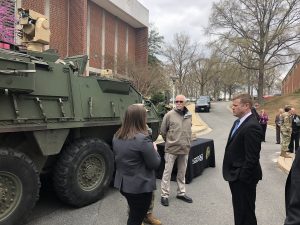
Under Secretary Ryan McCarthy (right) gets briefed on new sensors for the 8×8 Stryker vehicle
That kind of capability might seem more relevant against terrorists and guerrillas, than the Russian Army. While irregular forces strike from hiding and fall back, when the Russians are firing at you, the answer to “where’s it coming from?” tends to be “everywhere.” But with Vladimir Putin heavily reliant on deniable proxies and Spetsnaz commandos, any crisis will probably involve lone snipers instead of at least ahead of heavy mechanized forces.
What’s more, the researchers argued, automated threat detection will be critical for unmanned ground vehicles, which have no humans aboard to figure out where danger is coming from. The team is preparing sensor packages to go on both the Robotic Combat Vehicle and the “optionally manned” Next Generation Combat Vehicle with the prototypes enter testing in 2019. It’s part of a whole wave of technologies than the normally lumbering Army wants fast, fast, fast.
McCarthy Sums Up
“This helps me more than anybody,” Under Secretary McCarthy told reporters after the demonstrations, “because we’ve got these decisions coming up here by the middle of the summer for the POM 20” — the five-year budget plan (Program Objective Memorandum) for 2020-25.
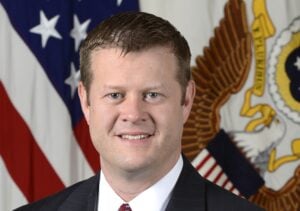
Ryan McCarthy
“(I’m) talking to researchers and operators about…the maturity of these investments, so you can make some of these hard choices. It’s very encouraging,” McCarthy said. “It gives you high confidence in some of these investments we’re going to make.”
McCarthy didn’t come to Belvoir alone. Besides his own staff, he brought the directors of three of the eight Cross Functional Teams (CFTs) spearheading different aspects of Army modernization: Brig. Gen. Chris Donahue, who heads the “soldier lethality” team; Maj. Gen. Peter Gallagher, networks team; and Maj. Gen. Maria Gervais, virtual and augmented reality training. Donahue is concerned with anything a soldier wears or carries, Gallagher’s network provides vital data that soldiers see on their displays, with Gervais’ simulators will project training scenarios on the same displays, superimposing fictional opponents and terrain on the real world.
McCarthy has visited some of the CFTs at their home bases, but he tries not to do it too much, he said, for fear of distracting or micromanaging them.
“I want to just allow them to do what they need to do. They’re empowered and they have our trust,” McCarthy said of the CFTs. “We stood them up in October and look at the progress they’ve made. That’s because, in large measure, we’ve given them guidance and resources, and they moved out.”
Subscribe to our newsletter
Promotions, new products and sales. Directly to your inbox.
